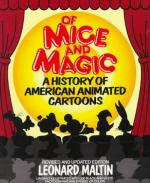|
This section contains 442 words (approx. 2 pages at 400 words per page) |

|
Of Mice and Magic: A History of American Animated Cartoons Summary & Study Guide Description
Of Mice and Magic: A History of American Animated Cartoons Summary & Study Guide includes comprehensive information and analysis to help you understand the book. This study guide contains the following sections:
This detailed literature summary also contains Topics for Discussion and a Free Quiz on Of Mice and Magic: A History of American Animated Cartoons by Leonard Maltin.
Leonard Maltin's "Of Mice and Magic: A History of American Animated Cartoons" is a work of non-fiction. The book is comprised of 13 chapters as well as a glossary and filmographies listed by studio.
The book begins with "The Silent Era," covering the birth of the cartoon short. The Silent Era ended in the 1920s when sound was first introduced in the film industry.
Chapters 2-12 contain history on the major players in the animation industry. Maltin covers how the industry grew and evolved, the major players involved, and the inventions and innovations that were enabled animation to evolve to its current level.
Maltin pays homage to the early influences in the industry, such as Winsor McCay and John Bray.
The chapters focus on individual studios, their contributions, techniques and people that made each of them great.
After the Silent Era, Maltin focuses on Walt Disney, by far one of the most innovative, creative and successful animators in history. Maltin covers Disney's early years up through the next several decades in which Disney would move to California, open his legendary studio and create some of the finest animation the world had ever seen or ever will see. Readers need not be told of Disney's successes with characters such as Mickey Mouse but the book covers the invention of every one.
Max Fleischer is the next animator to be discussed. Fleischer operated a studio with his brother Dave, a consummate comic. Fleischer's studio was relatively short-lived although some good work came out of it, including Betty Boop. Fleischer was a revolutionary inventor in the industry, holding 15 patents that included the Rotoscope and the Rotograph.
Paul Terry and Terrytoons is a chapter devoted to the creator of Aesop's Fables, a series that would run weekly for eight years. The series was said to inspire some of Walt Disney's early work.
Walter Lantz, creator of Woody Woodpecker, is also featured. Lantz had also created Andy Panda and realized much success in the animation industry.
One animator of note, Ub Iwerks, is discussed. Iwerks was a longtime protégé of Walt Disney until he had the offer of his own studio. After several years of success, Iwerks eventually returned to Disney's side.
Maltin focuses on the major studios and the roles they played in creating some of the most memorable characters in cartoon history. These include Paramount, Screen Gems, Universal, MGM, United Productions of America (UPA), United Artists, and Famous Studios.
Also included is an extensive filmography for each chapter and a glossary of terms.
Maltin ends the book with "The Rest of the Story," which follows animation into the 1960s and 1970s.
Read more from the Study Guide
|
This section contains 442 words (approx. 2 pages at 400 words per page) |

|



